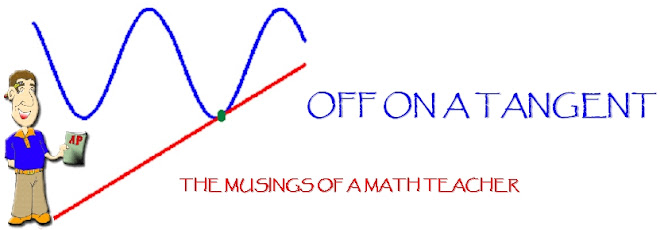
Read the following two verbal descriptions and think of the number each represents:
- "One hundred and ten thousand and one-tenth"
- "One hundred ten thousand and one-tenth"
Currently on an Electronic Discussion Group (EDG) or AP calculus teachers to which I subscribe, there has been much discussion and debate regarding a trifling use of semantics in mathematics: how to interpret the above verbal statements. I would personally indubitably interpret each statement to represent the number 110,000.1, my favorite fraction between 110,00 and 110,001, but not everyone would agree with me.
Although there are several, undebatable equivalent ways to mathematically write the answer (110,000.1 = 110,000 1/10 = 1,100,001/10) there is much debate on how to pronounce it. How would you read it? I know in my upper-level math classes, when writing the number, I would omit the commas, and when saying it, I would merely say "one ten oh oh oh point one." No student would misinterpret what I'm saying, because they understand place value and understand mathematical "slang" at this stage in their mathematical careers. But if I were teaching place-value and the correct procedure for precisely stating numbers (something my son is study
If I told you that both verbal statements are equivalent as written, would you get all ruffled up, get mad and upset! If you do, you are either extremely anal retentive, are and attorney or banker, or write a lot of checks (or all of the above.) People who disagree with the equivalence of the two statements may interpret them this way.
The first one: "One hundred and ten thousand and one-tenth"
The anal purists would say the word "and" is reserved for the fractional part of a number, expressed with the decimal point in the actual number. This description, then, literally means 100.10,000.1 which, with its TWO decimal places is meaningless (even when read in Europe, where they use decimals instead of commas.) There other extremists that go one step further, saying that the description actually implies the operation of addition! Do you see it? They argue the statements is 100 + 10000 + 0.1, interpreting the word "and" as the operation of addition.
Here's my take. The latter argument above is more genuine in the spirit of what is actually taking place. When students first learn place-value, they do so by "dissecting" the number into the sum of its respective parts as powers of 10. The number would be written as
110,000.1 = 100,000 + 10,000+0.1
If the "plus" sign is read as "and" then the we can read it as "One hundred thousand and ten thousand and one-tenth." Because this would be an awkward way to use the number in conversation, in the context of discussing quantities or magnitudes, we understand this to be equivalent to "One hundred and ten thousand and one-tenth." Example: "Did you see that the NASDAQ closed yesterday at one hundred and ten thousand and one-tenth?"
However, if we were discussing this number verbally in the context of amassing or listing a quantity or magnitude, we would interpret differently: "I need to find the sum of one hundred and ten thousand and one-tenth." This sum would be quite a different number:
100 + 10,000 + 0.1 = 10,100.1
Some would argue that the context in which a number is used should not be part of how to interpret it. These people claim that, with the two "and"s in the description is always equivalent to the smaller number obtained from the addition: 10,00.1Are you now more confused than you were at the beginning when you read the two statements originally? Let's try to re-clear it up.
The second argument: "One hundred ten thousand and one-tenth"
The second argument: "One hundred ten thousand and one-tenth"
I certainly see their point, but I can't say I ever lose sleep over it. Being a strict grammarian myself, with all the more egregious misinterpretations of verbal statements, I think this one is rather benign. I think students would see pursing this distinction would qualify for "making a mountain out of a mole hill" category.
This would essentially equate to listing three or more things in a sentence and the use of commas. In recent years, the keepers of the laws of grammar have accepted the omission of the final comma in a list: "I like to eat apples, bananas, and watermelon" is now correct to be written as "I like to eat apples, bananas and watermelons." Being more old school, I prefer the first style, additionally because it provides better clarification. To me, without the final comma, the last two, bananas and watermelon, should be treated as a single group rather than separate items.
For example, decide from this sentence exactly what I like to eat:
- "I like to eat chicken and rice and peas and carrots."
- "I like to eat chicken, rice, peas and carrots."
So have you figured out what I like to eat yet? If you were REALLY interested and were unsure, you could ask me to clarify (I like them all in any combo or casserole.)
In the end, I don't think it matters how the number is written or spoken, as long as the true intention can be discerned from the context. Grammatically, there is no consensus as to which is correct or "more" correct. We individuals are free to express ourselves within the constraints of what is acceptable, and this case is no exception. We use our personal judgement (and "YES" it is still acceptable to include the "e" after the "g.")
Now, the misuse of reflexive pronounce, is one I, myself, really get fired up about! Just ask myself sometime.






1 comment:
You lost me at "trifling use of semantics."
Post a Comment